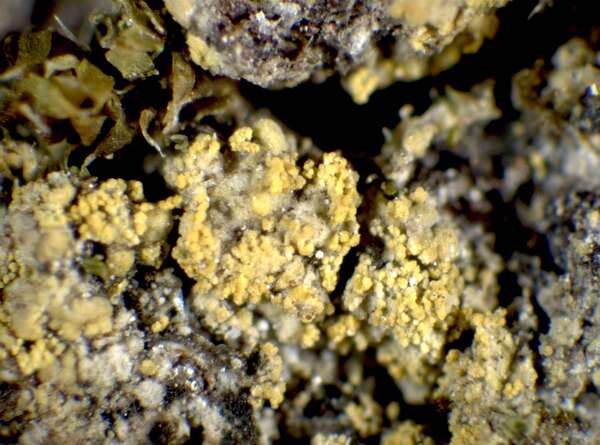Flavoplaca citrina (Hoffm.) Arup, Frödén & Søchting
Nord. J. Bot., 31: 44, 2013. Basionym: Verrucaria citrina Hoffm. - Deutschl. Fl.: 198, 1796.
Synonyms: Blastenia citrina (Hoffm.) B. de Lesd.; Callopisma citrinum (Hoffm.) A. Massal.; Caloplaca citrina (Hoffm.) Th. Fr.; Lecanora citrina (Hoffm.) Ach.; Lecanora murorum var. citrina (Hoffm.) Rabenh.; Lichen citrinus (Hoffm.) Ach.; Parmelia parietina var. citrina (Hoffm.) Schaer.; Placodium citrinum (Hoffm.) Hepp; Pyrenodesmia citrina (Hoffm.) Trevis.
Description: Thallus crustose, of scattered to continuous, 0.1-1(-1.5) mm wide areoles which soon dissolve into soredia, the esorediate parts flat to convex, pale greenish yellow to orange-yellow. Soredia concolorous with thallus, (25-)30-60(-75) µm. Cortex poorly developed or indistinctly paraplectenchymatous. Apothecia adnate to sessile, zeorine, 0.3-1.5 mm across, with a slightly concave to convex, yellow to yellow-orange disc, a slightly raised or level proper margin and a crenulate-sorediate thalline margin. Proper exciple (10-)25-50(-75) µm thick, of irregularly radiating, thick-walled, rather short-celled hyphae; epithecium yellowish orange, inspersed with granules, K+ purple-red; hymenium colourless, 70-80 µm high; paraphyses simple to sparingly branched in upper part, 2-2.5 µm thick at base, the apical cells swollen, to 7 µm thick; hypothecium colourless. Asci 8-spored, cylindrical-clavate, functionally unitunicate, apically thickened with a broad internal beak, the inner part of apex and external cap I+ blue, Teloschistes-type. Ascospores 2-celled, polarilocular, ellipsoid to broadly ellipsoid, 10-15 x (4-)5-7(-8) µm, the equatorial thickening (“septum”) (2.5–)3-5(-5) µm. Pycnidia immersed, orange. Conidia bacilliform to broadly ellipsoid, 2.5-3.8 x 1-1.5 µm. Photobiont chlorococcoid. Spot tests: thallus and apothecia K+ purple-red, C-, KC-, P-. Chemistry: thallus and apothecia with parietin (major), fallacinal, emodin, teloschistin and parietinic acid (minor), corresponding with chemosyndrome A of Søchting (1997).
Growth form: Crustose
Substrata: rocks
Photobiont: green algae other than Trentepohlia
Reproductive strategy: mainly asexual, by soredia, or soredia-like structures (e.g. blastidia)
Pioneer species
Commonnes-rarity: (info)
Alpine belt: absent
Subalpine belt: absent
Montane belt: absent
Dry submediterranean belt: absent
Humid submediterranean belt: absent
Padanian area: absent
pH of the substrata:
1 2 3 4 5
Solar irradiation:
1 2 3 4 5
Aridity:
1 2 3 4 5
Eutrophication:
1 2 3 4 5
Poleotolerance:
0 1 2 3
Altitudinal distribution:
1 2 3 4 5 6
Rarity
absent
extremely rare
very rare
rare
rather rare
rather common
common
very common
extremely common
Loading data...
Occurrence data
Predictive map
Growth form: Crustose
Substrata: rocks
Photobiont: green algae other than Trentepohlia
Reproductive strategy: mainly asexual, by soredia, or soredia-like structures (e.g. blastidia)
Pioneer species
Commonnes-rarity: (info)
Alpine belt: absent
Subalpine belt: absent
Montane belt: absent
Dry submediterranean belt: absent
Humid submediterranean belt: absent
Padanian area: absent
pH of the substrata:
| 1 | 2 | 3 | 4 | 5 |
Solar irradiation:
| 1 | 2 | 3 | 4 | 5 |
Aridity:
| 1 | 2 | 3 | 4 | 5 |
Eutrophication:
| 1 | 2 | 3 | 4 | 5 |
Poleotolerance:
| 0 | 1 | 2 | 3 |
Altitudinal distribution:
| 1 | 2 | 3 | 4 | 5 | 6 |
Rarity
absent
extremely rare
very rare
rare
rather rare
rather common
common
very common
extremely common
Loading data...
Occurrence data
Predictive map







